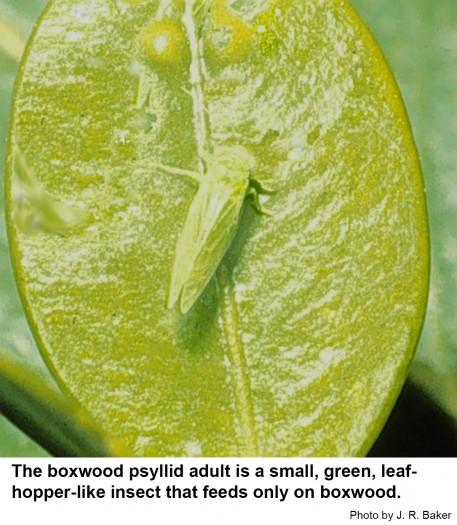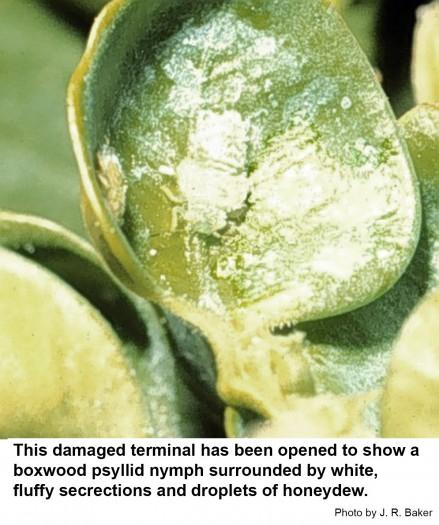Description and Biology
Boxwood psyllids, Cacopsylla buxi, are small (up to 1/8 inch), green, sucking insects that resemble leafhoppers or miniature cicadas. Boxwood psyllids overwinter as first instar nymphs still within their orange egg shells inserted between the bud scales in May and June. Eggs hatch as soon as the buds begin to open and the nymphs begin to feed on the expanding foliage, injecting their saliva and removing plant sap. Feeding injury produces cupping and curling of the leaves, enclosing several nymphs in the leaf pockets. The nymphs also produce white, fluffy secretions. Adults emerge in late May and June and mate. In July or August, female adults deposit one to seven eggs under each bud scale. Although adults continue to feed, they are not as damaging as nymphs.
Host Plants
Boxwood psyllids seem to occur wherever boxwoods are grown. In the United States, however, they are most common in temperate areas. Boxwood is the only known host of this pest. Although both American and English varieties are attacked, American boxwoods are more likely to be severely infested. Psyllid nymphs extract sap from buds and young foliage. As a result, terminal leaves of infested plants become cupped and twig growth may be stunted. Since the boxwood psyllid completes its single annual generation early in the growing season, plants sometimes outgrow their injury by midsummer.
Residential Recommendation
For control, early detection is essential to avoid leaf damage. Insecticides, including Orthene, imidacloprid, pyrethroids, Sevin, and insecticidal soaps are effective and should be applied as the leaves are expanding. Insecticide treatments applied after leaves have fully expanded (mid to late May) will not alleviate this year's damage, but may help to reduce psyllid numbers next year. When used as directed, pyrethroids are very toxic to insects but are not particularly hazardous to humans and pets (other than fish-avoid using pyrethroids around pools, ponds, and streams). Once inserted into the buds, the eggs are difficult to kill. In case of dry weather, irrigate the boxwoods well before treating to prevent damage caused by insecticides.
References
- Boxwood Psyllid. Childs, R. 2011 (revised). Univ. Mass. College of Nat. Sci. Landscape, Nursery & Urban Forestry Prog.
- Identifying Boxwood Psyllid. Larson, J. 2022 (revised). Univ. Kentucky College of Agr. Food and Environment Entomology fact sheet ENTFACT-454.
- Insect and Related Pests of Shrubs. Baker, J. R. ed. 1980. NC Agr. Extension Service pub. AG-189. 199 pp.
- Horticultural Science Publications
- North Carolina Agricultural Chemicals Manual
For assistance with a specific problem, contact your local N.C. Cooperative Extension Center
This Factsheet has not been peer reviewed.
Publication date: Dec. 4, 2013
Reviewed/Revised: Nov. 3, 2023
Recommendations for the use of agricultural chemicals are included in this publication as a convenience to the reader. The use of brand names and any mention or listing of commercial products or services in this publication does not imply endorsement by NC State University or N.C. A&T State University nor discrimination against similar products or services not mentioned. Individuals who use agricultural chemicals are responsible for ensuring that the intended use complies with current regulations and conforms to the product label. Be sure to obtain current information about usage regulations and examine a current product label before applying any chemical. For assistance, contact your local N.C. Cooperative Extension county center.
N.C. Cooperative Extension prohibits discrimination and harassment regardless of age, color, disability, family and marital status, gender identity, national origin, political beliefs, race, religion, sex (including pregnancy), sexual orientation and veteran status.


